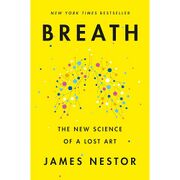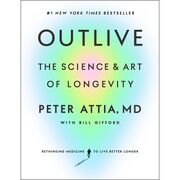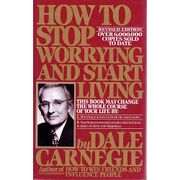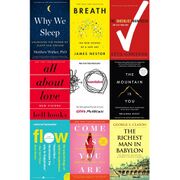Why We Sleep
🍎 Healthy brain food
"the shorter your sleep, the shorter your life."
— Matthew Walker, Why We Sleep (2017)
Introduction
| Why We Sleep | |
|---|---|
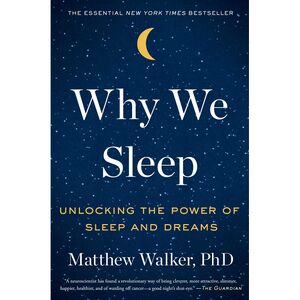 | |
| Full title | Why We Sleep: Unlocking the Power of Sleep and Dreams |
| Author | Matthew Walker |
| Language | English |
| Subject | Sleep; Dreams; Circadian rhythms; Health |
| Genre | Nonfiction; Popular science |
| Publisher | Scribner |
Publication date | 3 October 2017 |
| Publication place | United States |
| Media type | Print (hardcover, paperback); e-book; audiobook |
| Pages | 368 |
| ISBN | 978-1-5011-4431-8 |
| Goodreads rating | 4.4/5 (as of 6 November 2025) |
| Website | simonandschuster.com |
Why We Sleep is a popular-science book about the neuroscience and physiology of sleep, first published in the United States by Scribner on 3 October 2017 (368 pages; ISBN 978-1-5011-4431-8).[1][2] Written by neuroscientist Matthew P. Walker, a professor at the University of California, Berkeley, the book synthesizes laboratory, clinical, and epidemiological findings on how sleep and circadian biology shape learning, memory, emotion, immunity, metabolism, and long-term health.[3][1] It explains NREM/REM sleep and circadian rhythms, describes the consequences of insufficient sleep, and discusses practical topics such as caffeine, jet lag, melatonin, sleep disorders, and when behavioral therapy is preferable to sleeping pills.[1][4] The book is arranged in four parts—on what sleep is, why it matters, how and why we dream, and how society might change—presented in clear prose for general readers.[5][6] According to the publisher, it is a New York Times bestseller and an international sensation; it was named one of Publishers Weekly’s Best Books of 2017, and The Sunday Times’ year-end list recorded 162,125 UK copies sold in 2018.[1][7][8]
Chapter summary
This outline follows the Scribner hardcover first edition (3 October 2017; ISBN 978-1-5011-4431-8).[1][2]
I – This Thing Called Sleep
😴 1 – To Sleep…. Two-thirds of adults in developed nations miss the recommended eight hours. Consequences accrue quickly—immune suppression, metabolic dysregulation, and cardiovascular strain. Within a week, curtailed sleep can push blood sugar toward prediabetic levels, skew appetite hormones, and drive weight gain. Mood worsens—higher anxiety, lower resilience. Safety deteriorates: drowsy driving is a major contributor to U.S. crashes. The “I’ll sleep when I’m dead” mantra misleads; less sleep shortens and worsens life. Treat sleep like nutrition or exercise—a daily, non-negotiable input, not a reward.
☕ 2 – Caffeine, Jet Lag, and Melatonin: Losing and Gaining Control of Your Sleep Rhythm. In 1938, Nathaniel Kleitman and Bruce Richardson demonstrated that the brain’s circadian pacemaker persists without sunlight. Overlaid is homeostatic sleep pressure from adenosine, which builds during wake and urges sleep; caffeine blocks its receptors and lingers for hours. Jet engines added jet lag by leaping time zones; light and timed melatonin can shift the clock, but melatonin is a timing cue, not a general sedative.
⏳ 3 – Defining and Generating Sleep: Time Dilation and What We Learned from a Baby in 1952. Researchers use polysomnography—EEG, EOG, etc.—to map sleep stages. In 1952, Eugene Aserinsky and Nathaniel Kleitman identified REM sleep. Nights cycle ~90 minutes; early cycles are NREM-heavy, late cycles REM-tilted. Short nights first cut deep NREM; very late bedtimes slice REM.
🦍 4 – Ape Beds, Dinosaurs, and Napping with Half a Brain: Who Sleeps, How Do We Sleep, and How Much?. Sleep spans species. Marine mammals exhibit unihemispheric sleep—one hemisphere rests while the other remains vigilant. Across species, NREM/REM proportions vary with ecological demands.
👶 5 – Changes in Sleep Across the Life Span. Term infants sleep roughly 16–18 hours per day with high REM share, then consolidate. Teens experience a puberty-linked phase delay (later melatonin rise), so early school starts collide with biology. With aging, EEG shows less slow-wave NREM, more awakenings, and earlier circadian phase.
II – Why Should You Sleep?
🧠 6 – Your Mother and Shakespeare Knew: The Benefits of Sleep for the Brain. Odor cueing during slow-wave sleep improves recall of hippocampus-dependent facts (with fMRI changes), while late-night stage-2 NREM sleep spindles and naps support motor learning. In animals, hippocampal place cells replay routes during slow-wave sleep, linking new experience to long-term storage.
🏆 7 – Too Extreme for the Guinness Book of World Records: Sleep Deprivation and the Brain. In 1964, Randy Gardner stayed awake for 11 days under observation. Lab studies found that 14 days at 4–6 hours in bed produces cumulative performance deficits on the psychomotor vigilance task even as subjective sleepiness plateaus.[9] EEG and behavior expose microsleeps lasting fractions of a second—dangerous because people are unaware.
❤️ 8 – Cancer, Heart Attacks, and a Shorter Life: Sleep Deprivation and the Body. In 2019–2020 the International Agency for Research on Cancer classified night-shift work that disrupts circadian rhythms as “probably carcinogenic to humans” (Group 2A).[10][11] Short sleep impairs glucose tolerance and shifts appetite hormones—leptin down ~18%, ghrelin up ~28%—in controlled studies.[12]
III – How and Why We Dream
🌙 9 – Routinely Psychotic: REM-Sleep Dreaming. Michel Jouvet showed that disabling REM atonia in cats causes complex “acting out,” linking REM to behavior. Later brain imaging mapped REM’s pattern: limbic activation with dorsolateral prefrontal cortex downshift and noradrenaline suppression—vivid emotion with looser logic.
🛋️ 10 – Dreaming as Overnight Therapy. After a monitored night of sleep, emotional reactivity to previously seen images drops with strengthened prefrontal–limbic connectivity; with wakefulness alone it rises, consistent with REM reconsolidation effects.
🎨 11 – Dream Creativity and Dream Control. Historical anecdotes (Mendeleev, Loewi) echo lab results: more breakthroughs after sleep; Stephen LaBerge verified lucid dreaming in 1981 via pre-agreed eye signals, and later work modulated lucidity markers with external stimulation.
IV – From Sleeping Pills to Society Transformed
👻 12 – Things That Go Bump in the Night: Sleep Disorders and Death Caused by No Sleep. In 1986, neurologist Elio Lugaresi’s group described fatal familial insomnia, a prion disease with selective thalamic nuclei degeneration; subsequent work linked the syndrome to a PRNP D178N mutation.[13][14] Animal deprivation work at the University of Chicago using the disk-over-water method demonstrated that prolonged total or REM-specific deprivation leads to systemic failure and death.[15][16] REM sleep behavior disorder (RBD) often precedes Parkinson’s spectrum disease, making it an early warning sign in neurology.
📱 13 – iPads, Factory Whistles, and Nightcaps: What’s Stopping You from Sleeping?. Inpatient studies show that evening LED screens suppress melatonin, delay internal time, lengthen sleep onset, and blunt next-morning alertness under otherwise controlled conditions.[17] Night-shift work’s carcinogenic classification underscores the systemic toll of chronic circadian disruption.[10][11] Alcohol fragments sleep and trims REM later in the night; temperature, irregular schedules, noise, and late caffeine compound the mismatch between body clock and social clock.
💊 14 – Hurting and Helping Your Sleep: Pills vs. Therapy. A JAMA trial in older adults found that six weeks of CBT-I improved objective sleep efficiency and slow-wave sleep at six months, whereas nightly zopiclone did not provide durable benefit over placebo.[18] In 2016 the American College of Physicians recommended CBT-I as first-line treatment for chronic insomnia.[19] A 2015 Annals meta-analysis showed ~19 minutes faster sleep onset, ~26 minutes less wake after sleep onset, and ~10 percentage points higher sleep efficiency, with durable effects.[20] In 2019 the U.S. FDA added a boxed warning to zolpidem, zaleplon, and eszopiclone for rare but serious “complex sleep behaviors.”[21]
🏛️ 15 – Sleep and Society: What Medicine and Education Are Doing Wrong; What Google and NASA Are Doing Right. In long-haul aviation, planned 40-minute cockpit rest led to average naps of ~26 minutes and improved alertness and performance without compromising safety, informing modern fatigue countermeasures.[22] Schools show timing at scale: multi-district studies led by the University of Minnesota found that delaying high-school start times (e.g., 7:35 a.m. → 8:55 a.m.) reduced teen car crashes—by about 70% in Jackson Hole, Wyoming—and improved grades and attendance.[23][24] In medicine, extended overnight shifts increase serious errors and post-shift crash risk, driving reforms in resident schedules.[25][26]
🔭 16 – A New Vision for Sleep in the Twenty-First Century. Organizations and schools can align schedules with circadian biology using later starts, strategic naps, and sleep-positive incentives; infrastructure—smarter evening light, cooler bedrooms, “bedtime alarms”—makes good sleep automatic. I believe it is time for us to reclaim our right to a full night of sleep, without embarrassment or the damaging stigma of laziness.
Background & reception
🖋️ Author & writing. Matthew P. Walker is Professor of Neuroscience and Psychology at the University of California, Berkeley, and founder/director of the Center for Human Sleep Science; his academic work focuses on sleep’s role in memory, emotion, and health.[3] His laboratory studies use EEG and MRI among other methods, an approach that underpins the book’s explanations and case studies.[27] The book aims to translate this body of evidence for general readers and to reframe insufficient sleep as a public-health problem.[4] Its four-part structure mirrors that goal.[5][1]
📈 Commercial reception. The publisher reports that Why We Sleep is a New York Times bestseller and an international sensation.[1] In the UK, The Sunday Times listed it among the year’s bestsellers in 2018 with 162,125 copies sold.[8] In the trade press, it was selected as one of Publishers Weekly’s Best Books of 2017.[7]
👍 Praise. Mark O’Connell in The Guardian welcomed the book’s urgent message and described it as “an eye-opener.”[28] Clive Cookson in the Financial Times called it “stimulating and important,” summarising evidence linking sleep to cognition and disease.[29] Kirkus Reviews highlighted its accessible treatment of REM/NREM, memory, and health for a general audience.[6] Times Higher Education also praised its account of circadian disruption and modern habits.[30]
👎 Criticism. Zoë Heller in The New Yorker questioned some extrapolations and aspects of dream interpretation.[31] The Financial Times noted that some experts dispute claims about a broad decline in average sleep duration.[29] In an academic review in Organization Studies, Anu Valtonen critiqued the book’s neuroscientific framing.[32] Columbia University statistician Andrew Gelman also collated criticisms of headline claims.[33]
🌍 Impact & adoption. Walker promoted the book’s themes in mainstream media, including an interview on NPR’s Fresh Air on 16 October 2017.[34] He discussed practical sleep hygiene on CBS This Morning the same week.[35] In April 2019 his TED talk, “Sleep is your superpower,” amplified the message globally, followed by TED’s Sleeping with Science series.[36][37]
Related content & more
YouTube videos
CapSach articles
Enjoyed this page?
📚If this page Why We Sleep inspired or helped you today, a small coffee helps us keep creating and sharing more. Your support truly matters.👏
References
- ↑ 1.0 1.1 1.2 1.3 1.4 1.5 1.6 "Why We Sleep". Simon & Schuster. Simon & Schuster. 3 October 2017. Retrieved 6 November 2025.
- ↑ 2.0 2.1 "Why we sleep : unlocking the power of sleep and dreams". WorldCat. OCLC. Retrieved 6 November 2025.
- ↑ 3.0 3.1 "Matthew P. Walker". UC Berkeley Department of Psychology. University of California, Berkeley. Retrieved 6 November 2025.
- ↑ 4.0 4.1 Anwar, Yasmin (17 October 2017). "Everything you need to know about sleep, but are too tired to ask". UC Berkeley News. University of California, Berkeley. Retrieved 6 November 2025.
- ↑ 5.0 5.1 "Why we sleep : unlocking the power of sleep and dreams (table of contents)". WorldCat. OCLC. Retrieved 6 November 2025.
- ↑ 6.0 6.1 "Why We Sleep". Kirkus Reviews. 21 August 2017. Retrieved 6 November 2025.
- ↑ 7.0 7.1 "Best Books 2017". Publishers Weekly. Retrieved 6 November 2025.
- ↑ 8.0 8.1 "Books: The Sunday Times Bestsellers of the Year, 2018". The Sunday Times. 30 December 2018. Retrieved 6 November 2025.
- ↑ Van Dongen, H. P. A.; Maislin, G.; Mullington, J. M.; Dinges, D. F. (1 March 2003). "The Cumulative Cost of Additional Wakefulness: Dose–Response Effects on Neurobehavioral Functions and Sleep Physiology From Chronic Sleep Restriction and Total Sleep Deprivation". Sleep. 26 (2): 117–126. PMID 12683469. Retrieved 6 November 2025.
- ↑ 10.0 10.1 "IARC Monographs Volume 124: Night Shift Work". IARC. 2 June 2020. Retrieved 6 November 2025.
- ↑ 11.0 11.1 "Night Shift Work (4–11 June 2019): Questions and Answers" (PDF). IARC. 5 July 2019. Retrieved 6 November 2025.
- ↑ Spiegel, K.; Tasali, E.; Penev, P.; Van Cauter, E. (7 December 2004). "Brief Communication: Sleep Curtailment in Healthy Young Men Is Associated with Decreased Leptin Levels, Elevated Ghrelin Levels, and Increased Hunger and Appetite". Annals of Internal Medicine. 141 (11): 846–850. doi:10.7326/0003-4819-141-11-200412070-00008. PMID 15583226.
- ↑ Lugaresi, E.; Medori, R.; Tarantini, C.; et al. (16 October 1986). "Fatal familial insomnia and dysautonomia with selective degeneration of thalamic nuclei". The New England Journal of Medicine. 315 (16): 997–1003. doi:10.1056/NEJM198610163151605. PMID 3762620.
{{cite journal}}: Explicit use of et al. in:|author4=(help) - ↑ "Fatal Familial Insomnia". StatPearls (NCBI Bookshelf). StatPearls Publishing. 2024. Retrieved 6 November 2025.
- ↑ Rechtschaffen, A.; Bergmann, B. M. (July–August 1995). "Sleep deprivation in the rat by the disk-over-water method". Behavioural Brain Research. 69 (1–2): 55–63. doi:10.1016/0166-4328(95)00020-T. PMID 7546318.
- ↑ Rechtschaffen, A. (1 January 2002). "Sleep Deprivation in the Rat: An Update of the 1989 Paper" (PDF). Sleep. 25 (1): 18–24. Retrieved 6 November 2025.
- ↑ Chang, A.-M.; Aeschbach, D.; Duffy, J. F.; Czeisler, C. A. (14 January 2015). "Evening use of light-emitting eReaders negatively affects sleep, circadian timing, and next-morning alertness". Proceedings of the National Academy of Sciences. 112 (4): 1232–1237. doi:10.1073/pnas.1418490112. Retrieved 6 November 2025.
- ↑ Sivertsen, B.; Omvik, S.; Pallesen, S.; et al. (28 June 2006). "Cognitive Behavioral Therapy vs Zopiclone for Treatment of Chronic Primary Insomnia in Older Adults: A Randomized Controlled Trial". JAMA. 295 (24): 2851–2858. doi:10.1001/jama.295.24.2851.
{{cite journal}}: Explicit use of et al. in:|author4=(help) - ↑ Qaseem, A.; et al. (19 July 2016). "Management of Chronic Insomnia Disorder in Adults: A Clinical Practice Guideline From the American College of Physicians". Annals of Internal Medicine. 165 (2): 125–133. doi:10.7326/M15-2175.
{{cite journal}}: Explicit use of et al. in:|author2=(help) - ↑ Trauer, J. M.; et al. (4 August 2015). "Cognitive Behavioral Therapy for Chronic Insomnia: A Systematic Review and Meta-analysis". Annals of Internal Medicine. 163 (3): 191–204. doi:10.7326/M14-2841.
{{cite journal}}: Explicit use of et al. in:|author2=(help) - ↑ "FDA adds Boxed Warning for risk of serious injuries caused by sleepwalking with certain prescription insomnia medicines". U.S. Food & Drug Administration. 30 April 2019. Retrieved 6 November 2025.
- ↑ Rosekind, M. R. (1994). "Crew Factors in Flight Operations IX: Effects of Planned Cockpit Rest on Crew Performance and Alertness in Long-Haul Operations" (PDF). NASA Technical Reports Server. Retrieved 6 November 2025.
- ↑ "Examining the Impact of Later High School Start Times on Health and Academic Performance of High School Students". University of Minnesota. 2014. Retrieved 6 November 2025.
- ↑ Wahlstrom, K. (2014). "Examining the Impact of Later High School Start Times" (PDF). ERIC/US Dept. of Education. Retrieved 6 November 2025.
- ↑ Landrigan, C. P.; et al. (28 October 2004). "Effect of Reducing Interns' Work Hours on Serious Medical Errors in Intensive Care Units". The New England Journal of Medicine. 351: 1838–1848.
{{cite journal}}: Explicit use of et al. in:|author2=(help) - ↑ Barger, L. K.; et al. (27 January 2005). "Extended Work Shifts and the Risk of Motor Vehicle Crashes among Interns". The New England Journal of Medicine. 352: 125–134.
{{cite journal}}: Explicit use of et al. in:|author2=(help) - ↑ "Sleep and Neuroimaging Lab — Research focus". Center for Human Sleep Science, UC Berkeley. University of California, Berkeley. Retrieved 6 November 2025.
- ↑ O'Connell, Mark (21 September 2017). "Why We Sleep by Matthew Walker review – how more sleep can save your life". The Guardian. Retrieved 6 November 2025.
- ↑ 29.0 29.1 Cookson, Clive (3 October 2017). "Why We Sleep by Matthew Walker — for a longer life, press snooze". Financial Times. Retrieved 6 November 2025.
- ↑ "Review: Why We Sleep, by Matthew Walker". Times Higher Education. 5 October 2017. Retrieved 6 November 2025.
- ↑ Heller, Zoë (10 December 2018). "Why We Sleep, and Why We Often Can't". The New Yorker. Retrieved 6 November 2025.
- ↑ Valtonen, Anu (20 February 2019). "The new science of sleep and dreams (Book review: Why We Sleep)". Organization Studies. 40 (5). doi:10.1177/0170840619831946. Retrieved 6 November 2025.
- ↑ Gelman, Andrew (18 November 2019). "Is Matthew Walker's "Why We Sleep" Riddled with Scientific and Factual Errors?". Statistical Modeling, Causal Inference, and Social Science. Columbia University. Retrieved 6 November 2025.
- ↑ "Sleep Scientist Warns Against Walking Through Life 'In An Underslept State'". Fresh Air Archive. WHYY/NPR. 16 October 2017. Retrieved 6 November 2025.
- ↑ "The health costs of losing sleep and tips for getting a good night's rest". CBS News. 11 October 2017. Retrieved 6 November 2025.
- ↑ "Matt Walker: Sleep is your superpower". TED.com. 2019. Retrieved 6 November 2025.
- ↑ "Sleeping with Science". TED.com. Retrieved 6 November 2025.

